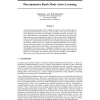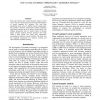1134 search results - page 138 / 227 » Sequential Inductive Learning |
NIPS
2007
14 years 11 months ago
2007
Active learning sequentially selects unlabeled instances to label with the goal of reducing the effort needed to learn a good classifier. Most previous studies in active learning...
ICML
2008
IEEE
15 years 10 months ago
2008
IEEE
In inductive logic programming, subsumption is a widely used coverage test. Unfortunately, testing -subsumption is NP-complete, which represents a crucial efficiency bottleneck fo...
AB
2007
Springer
15 years 4 months ago
2007
Springer
Whenever a programmer writes a loop, or a mathematician does a proof by induction, an invariant is involved. The discovery and understanding of invariants often underlies problem s...
105
click to vote
ECAI
2004
Springer
15 years 1 months ago
2004
Springer
Functional genomics is a typical scientific discovery domain characterized by a very large number of attributes (genes) relative to the number of examples (observations). The dang...
FLAIRS
2008
15 years 8 days ago
2008
This study explores how Latent Semantic Analysis (LSA) can be used as a method to examine the lexical development of second language (L2) speakers. This year long longitudinal stu...


